Multinational Inscription of Kebaya on the UNESCO List
This stamp issue commemorates the multinational inscription of Kebaya on the UNESCO Representative List of Intangible Cultural Heritage by Brunei, Indonesia, Malaysia, Singapore, and Thailand. Worn by women across Southeast Asia, the kebaya is an upper garment symbolizing the shared cultural heritage of the five nominating countries. It is characterized by its distinctive design, secured at the front with buttons, pins, or a brooch, and is often paired with a sarong or kain. In Singapore, the kebaya continues to play a significant role in Singapore’s cultural tapestry, bridging past, present, and future.
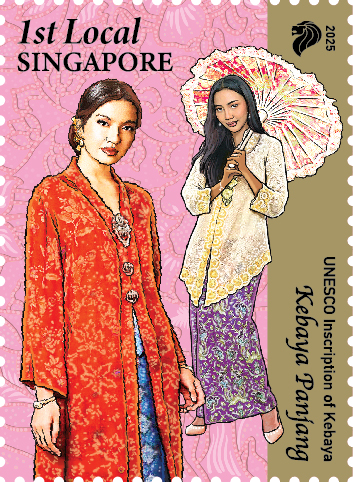
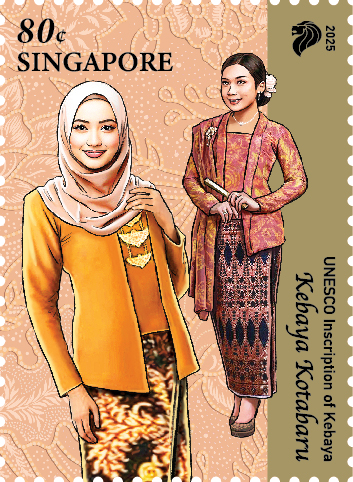
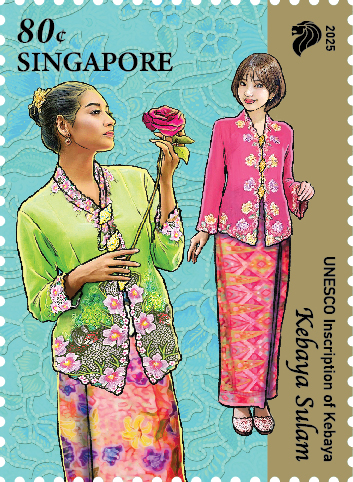
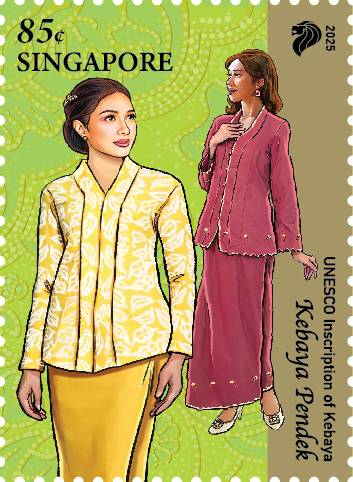
1st Local Stamp: Kebaya panjang - A full-length dress with a front opening that is traditionally fastened with either kerongsang (brooch), pins or buttons.
80¢ Stamp: Kebaya kotabaru- Distinguished by a rectangular-shaped panel that connects the front opening of the garment.
80¢ Stamp: Kebaya sulam - Features elaborate embroidery of flowers, animals, mythical creatures, or figurative elements. The embroidery may be found throughout or along the edges, such as the neckline, sleeves, and bottom ends of the kebaya.
85¢ Stamp: Kebaya pendek - A short kebaya that reaches the hip and is recognisable through its distinct figure-hugging characteristic that is made to emphasise the silhouette of the body.
Singapore’s Modern Architectural Heritage
Since 1989, the Urban Redevelopment Authority (URA) has conserved over 7,200 heritage buildings in Singapore. This stamp series celebrates Singapore's modern architecture from the 1950s to the 1970s, a period of innovation that addressed the needs of a growing nation. These buildings are characterized by their use of reinforced concrete and simple, geometric designs adapted for the tropical climate. The stamps feature five protected buildings from this era: the Former Customs Harbour Branch, Former Singapore Conference Hall and Trade Union House, Former Golden Mile Complex, Queenstown Public Library, and Kwong Wai Shiu Hospital Main Block.
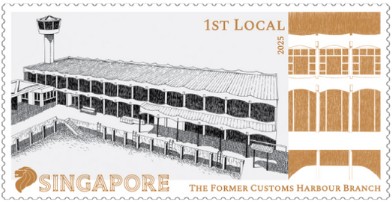
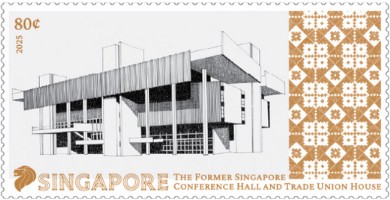
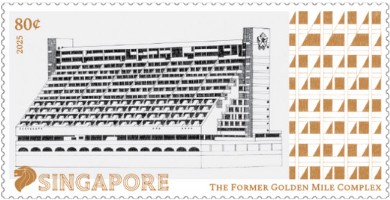
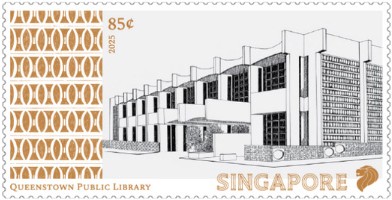
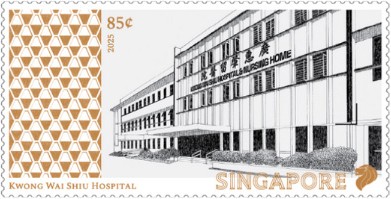
1st Local Stamp: The Former Customs Harbour Branch at 70 Collyer Quay
Built by the then Public Works Department, the building features a ribbed concrete roof with butterfly panels and an observation tower for round-the-clock harbour surveillance. It symbolised Singapore's commitment to securing maritime trade - a crucial aspect of economic progress. It was gazetted for conservation on 14 March 2007.
80¢ Stamp: The Former Singapore Conference Hall and Trade Union House at 7 Shenton Way
Designed by the then Malayan Architects Co-Partnership, the venue exemplifies the hopes and courage of a young nation. Beyond hosting key labour and cultural events in the early years of independence, it incorporates local materials and aesthetics such as Malay weaving patterns on the wall tiles. It was gazetted as a National Monument on 28 December 2010.
80¢ Stamp: The Former Golden Mile Complex at 5001 Beach Road
This 16-storey building with its iconic stepped terrace design was designed by the then Design Partnership. Embodying the vision of a "megastructure", it stands as an early prototype for integrating shops, offices and apartments within a unified urban form – a landmark of the progressive and can-do spirit of our pioneering generation. It was gazetted for conservation on 18 October 2021.
85¢ Stamp: Queenstown Public Library at 53 Margaret Drive
Built in the heart of Queenstown, Singapore's first branch library is a demonstration of the national commitment to uplifting literacy. Its distinctive ‘bowtie’ canopies, floor-to-ceiling windows, and sun-shading blocks resembling the letter ‘Q’ address our tropical climate. It was gazetted for conservation on 6 June 2014.
85¢ Stamp: Kwong Wai Shiu Hospital Main Block at 705 Serangoon Road
A landmark in Boon Keng, the main block was built with community support. Today, it still serves the public as a healthcare facility. Besides accommodating over 300 patients, its rhythmic façade of sun-shading fins, windows and breeze blocks enhances users’ comfort. It was gazetted for conservation on 21 September 2012.
The Peranankan Museum
The Peranakan Museum presents the cross-cultural art of Peranakan communities in Southeast Asia. Installed in the former Tao Nan School, built in 1912, it holds one of the world’s finest public collections of Peranakan objects. Three floors explore Peranakan life through themes related to origins, home, and style as aspects of identity. Community interviews, recorded demonstrations, art commissions, and other contemporary expressions of Peranakan culture provide a multi-faceted experience for visitors, encouraging them to ask themselves: “what is Peranakan?”. This stamp issue features items that explore Peranakan life. The Peranakan Museum is a department of the Asian Civilisations Museum, operating under the National Heritage Board.
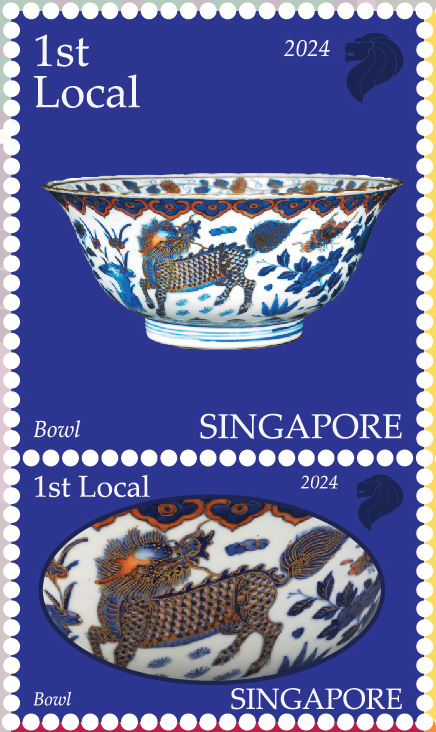
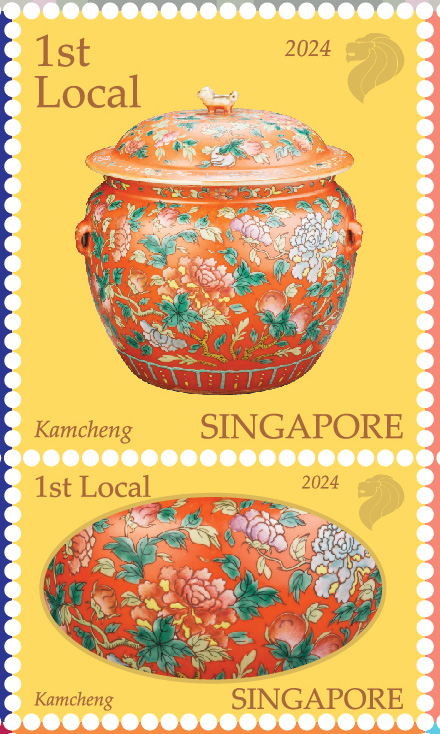
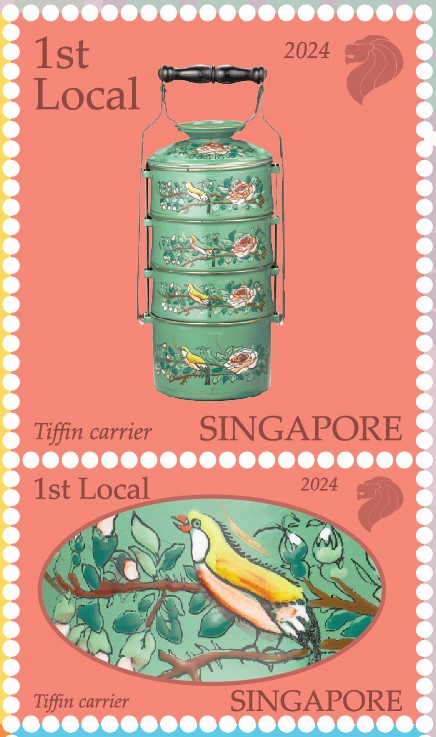
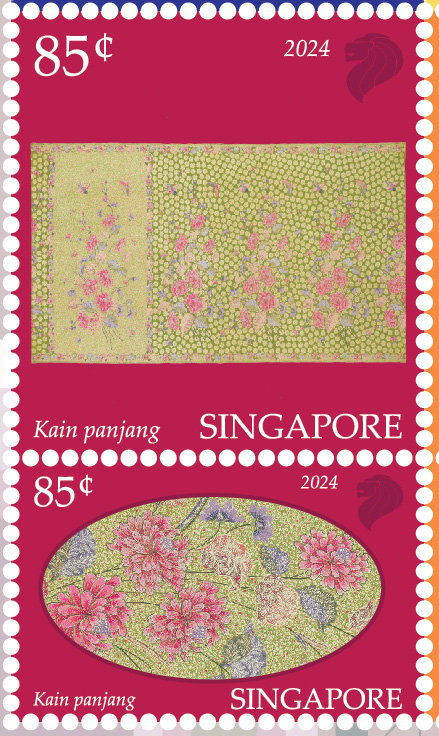
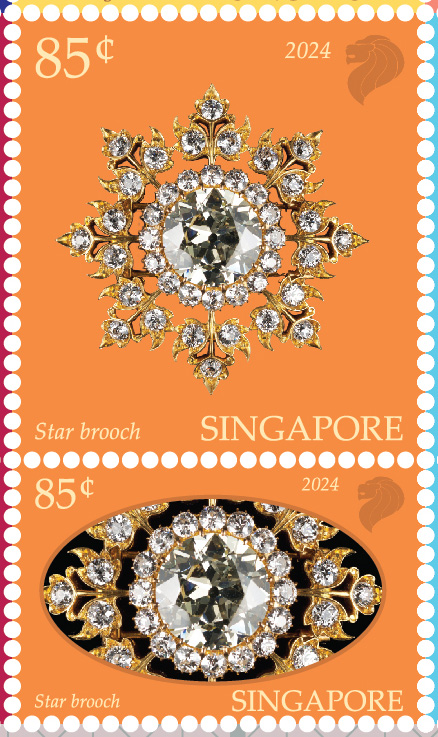
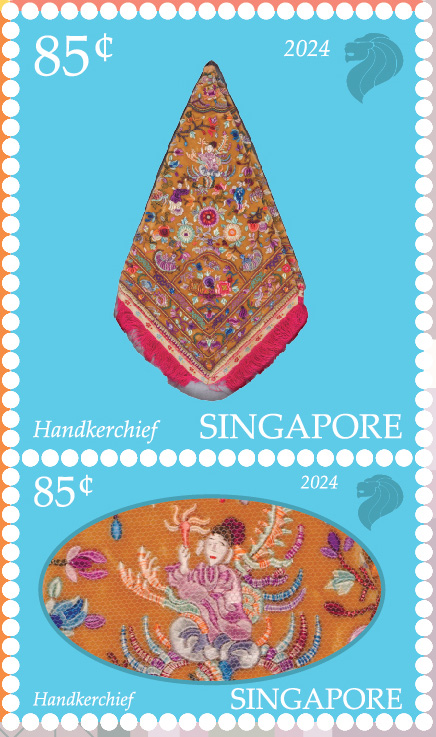
1st Local Stamp: Bowl
Some Chinese Peranakan families commissioned porcelain with family names, hallmarks, or auspicious motifs for special occasions. This blue-and-white gilded porcelain bowl with qilin and phoenix motifs was likely commissioned by the family of the Peranakan merchant and philanthropist Cheang Hong Lim (1825–1893). They are marked with the name of his company, Wan Seng 苑生.
1st Local Stamp: Kamcheng
Ceramics were an integral part of Peranakan social, ritual, and culinary life. Peranakan porcelain, called “nyonyaware” after the Peranakan Chinese women who favoured them, is characterised by an exuberant use of colour. Kamcheng have various functions and were made in a wide variety of sizes and colours. They were used for storing water, soups, desserts, and pickles for special occasions. Miniature versions were also used as cosmetics containers.
1st Local Stamp: Tiffin carrier
This four-tiered tiffin carrier, also known as a “tingkat", was probably used to deliver food to customers or by workers to carry their lunch. It is opened by unlocking a small catch on either side of the handle, which is then removed.
85¢ Stamp: Kain panjang
A kain panjang is a type of cloth used as a hip wrapper by both men and women. This batik, signed “Nj: Oeij Kok Sing”, was made using a technique that involves applying wax with a pen-like instrument called a canting. It features a repeated floral buketan (bouquet) motif.
85¢ Stamp: Star-shaped fastener or brooch
Many elements in Peranakan jewellery are borrowed from or shared with other communities. This fastener (kerosang in Malay) has at its centre a large diamond enclosed by a detachable border of sixteen diamonds. Another twenty-four diamonds are set in foliate outlines giving it a star-shaped form.
85¢ Stamp: Handkerchief
Peranakan women wore handkerchiefs in multiple ways. Elaborately embroidered silk and velvet handkerchiefs were meant for formal occasions, while batik and printed cotton versions were for everyday use. The central figure on this embroidered handkerchief is Shou Lao, the Chinese God of Longevity, riding a crane. He is accompanied by two of the Eight Immortals, Cao Guojiu on a turtle and Li Tieguai on a prawn. The horseshoe crab is native to Southeast Asia and is seen as a symbol of good fortune.











